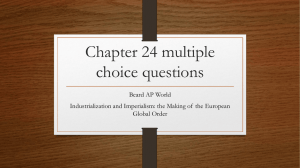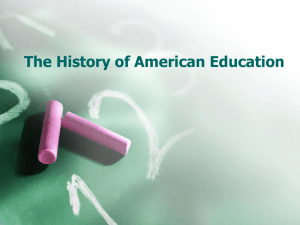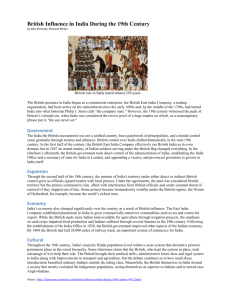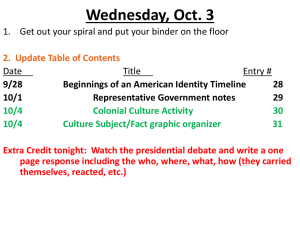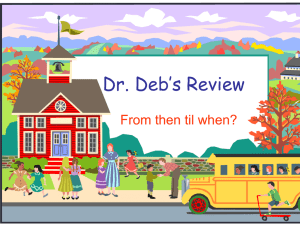Feb. 10, 2004 Read: Skolnick, The life course revolution
advertisement
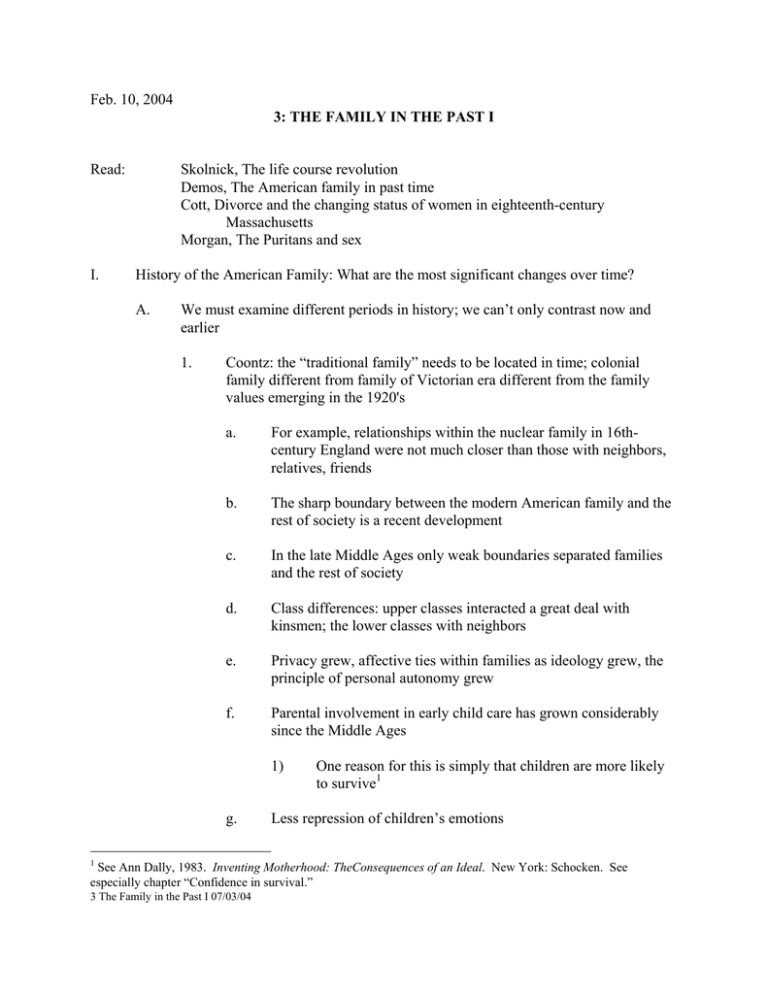
Feb. 10, 2004 3: THE FAMILY IN THE PAST I Read: I. Skolnick, The life course revolution Demos, The American family in past time Cott, Divorce and the changing status of women in eighteenth-century Massachusetts Morgan, The Puritans and sex History of the American Family: What are the most significant changes over time? A. We must examine different periods in history; we can’t only contrast now and earlier 1. Coontz: the “traditional family” needs to be located in time; colonial family different from family of Victorian era different from the family values emerging in the 1920's a. For example, relationships within the nuclear family in 16thcentury England were not much closer than those with neighbors, relatives, friends b. The sharp boundary between the modern American family and the rest of society is a recent development c. In the late Middle Ages only weak boundaries separated families and the rest of society d. Class differences: upper classes interacted a great deal with kinsmen; the lower classes with neighbors e. Privacy grew, affective ties within families as ideology grew, the principle of personal autonomy grew f. Parental involvement in early child care has grown considerably since the Middle Ages 1) g. 1 One reason for this is simply that children are more likely to survive1 Less repression of children’s emotions See Ann Dally, 1983. Inventing Motherhood: TheConsequences of an Ideal. New York: Schocken. See especially chapter “Confidence in survival.” 3 The Family in the Past I 07/03/04 2 1) Now we try to understand their needs, don’t think of them as born evil (Demos’ point) h. The role of father in the catechizing and educating of young children has diminished i. A crucial tension still with us: the power of parents versus the power of state 1) Current examples are teenage abortion rights and the general question of authority with respect to the reproductive behavior of minor children 2) Not until late in the 19th century was there legislation to protect children from abusive parents, “since the parentchild relationship was regarded as sacred and beyond state intervention” (Vinovskis) a) II. In this course we will speak of 3 stages of the history of the American family A. III. The movement began with the argument that the protections offered by the society for the prevention of cruelty to animals should be extended to children The colonial period, the 19th century and 20th—–basically 1820 to 1920 and then the present (Skolnick) The colonial period: A. Family was an economic, instrumental institution; the father was boss over the family enterprise B. Everyone “worked” C. Children were considered to be miniature adults 1. Worked, dressed, associated with adults, church... 2. They came into the world corrupted and selfish 3. Colonial America barely recognized childhood as we know it, and certainly did not recognize adolescence 3 4. D. One’s children were baby sitters of their younger siblings, and mother’s and father’s helpers The family was the primary unit of economic production and exchange 1. Women did “real” work (productive work) a. Food, clothing, hand sewing, weaving, spinning 2. Overall, fathers worked, ate, etc., at home 3. No notion of the man as “breadwinner” 4. Family members who stayed at home weren’t seen as economic burdens, as is the case today 5. Evidence: adoption before the turn of the last century occurred mainly of older boys, as economic assets a. Preferential adoption of infant girls, characteristic of the 20th century, was definitely not the ideal then b. Only kin adopted infants 1) 6. Work was shared a. E. Foundlings, even infants who had kin, were often consigned to orphanages Far more interaction within the family overall than occurs today Less autonomy 1. As Demos points out, the family was part of the commonwealth, and the commonwealth had a substantial say in what happened in its families 2. A strong shift took place in the 19th century towards family autonomy a. 3. Currently it’s interesting to analyze the feelings against “interference” of the state, local communities, schools (e.g., sex education) In colonial times the courts would interfere in family problems 4 a. 4. Even criminals were lodged in families; it was felt to be better for them a. F. G. For example it would put couples back together Everyone belonged in a family Keep in mind that in colonial America “family” does not equal “household,” does not equal “nuclear family” 1. Other people were present (grandparents at times, hired hands, etc.) 2. But pattern was not 2 generations of intact married couples living together Other functions of the colonial family 1. Education...the family was the chief agency a. Education away from home came to be needed during the 19th century with the coming of the industrial revolution 1) 2. Perhaps only in an agrarian situation can children be miniature adults The family was the source of what we know as welfare; people depended on their family for these forms of social security a. However, children were not as dependent on the family for their future as were their contemporaries in Europe b. Why? c. 1) They could move west, didn’t need to toe the line to get their inheritance 2) They could threaten to move to gain leverage 3) Also—a common immigrant theme even today—the children were more flexible and adaptable in the new country Women, too, had more power in colonial America than in England or, subsequently, in the 19th century 1) They were scarce 5 3. 2) They could own property...work away from home, own taverns, inns, etc. 3) But, yes, they were considered untrustworthy Demos makes a nice point about sexuality before the 19th century a. Court records indicate that in some communities, between 1/3 and 1/2 of the women went to the altar pregnant 1) A familiar theme: pregnancy as a way of getting married as well as the usual “careless love” idea a) 2) IIV. Or, as Demos points out, a way to foist the blame for an illegitimate child on someone not the father Obviously premarital sex didn’t carry the opprobrium it came to have in the 19th century Changes in the 19th century A. The industrial revolution resulted in much more productive work taking place outside the household B. New roles for women 1. And sharper distinctions between women’s roles and men’s roles, masculinity and femininity 2. Victorian notions of femininity is now termed the “Cult of True Womanhood”—a reading for Thursday by Barbara Welter 3. Unlike the colonial period, the sexuality of men came to be seen as unfortunate 4. Women came to be seen as not having any sexual drive—if they were “proper” women a. 5. Only a drive to reproduce These new ideas probably had some disastrous effects in marriages a. The small amount of communication regarding sex was merely an 6 extreme case of a pattern that affected every sort of contact between men and women 6. C. The spheres were rigidly separated The new trends of urbanization, industrialization produced undercurrents of fear not present in the colonial era 1. Enter the idea of the home as refuge, retreat: Home Two birds within one nest; Two hearts within one breast; Two souls within one fair Firm league of love and prayer, Together bound for aye, together blest. An ear that waits to catch A hand upon the latch’ A step that hastens its sweet rest to win; A world of care without A world of strife shut out, A world of love shut in. Dora Greenwell, Cornhill Magazine, Sept. 1863 2. D. Wouldn’t have made sense in colonial America Contradictions in the roles of both men and women resulted 1. 2. Men: an image of strength, cunning, inventiveness, endurance—masculine traits a. A go-ahead spirit, but there was also a fear of men devouring one another b. And a loss of the old values Enter the woman a. She represented Home: the tender virtues... men get their hands dirty, but are saved because of the image of the saint they carry before them 7 3. Expectably, women’s status declined a. They were less productive, came to have less power, etc. b. Couldn’t work outside the home 1) 4. E. Poor women and female slaves were excluded from this ideology, of course a) Famous saying by former slave Sojourner Truth, “Aint I a Woman?” pointed out this contradiction b) The issue was protective legislation for women in the workplace c) That would result in restricting women’s ability to get jobs d) She was pointing out that there had been no interest in protecting her, or other working class women from heavy labor “The domestic hearth was their altar and their prison” Other consequences 1. Childhood became problematic in a way it hadn’t been a. The family could no longer train their children for the jobs they were likely to take b. Children came to be seen as a creature inherently different from adults c. The beginnings of interest in child rearing literature and experts— a huge number of publications (no equivalent in Europe) d. Built-in contradictions about how children should turn out 1) Expressive, independent, find himself, go ahead, individualistic 2) But controlled—and doing the right thing 8 e. 2. 3. F. And the family came to be seen as more and more responsible for how the child turns out Enter the notion of an identity crisis a. It used to be that a youth received an adult identity in the natural course of things b. Beginning in the 19th century, continuing to the present, all kinds of possible alternatives in one’s: 1) Career 2) Lifestyle 3) Moral and philosophical beliefs And ever-increasing individualism a. Decisions used to be more family-centered b. The family as an instrumental institution declined—many more things were done within the family c. And, as a result, the family had more economic clout—power— over its nonproductive members d. The family provided increasing less identity to members...family roles, work roles e. Individualistic patterns established during the 19th century with the emergence of the urban middle class Demos says there never was a golden age of the family; so do Coontz and the Skolnicks’ Introduction 1. There have always been conflicts between individual needs and family needs 2. There are two ways to see recent trends a. For example, yes, high divorce rates now 9 1) But there used to be a lot of desertion a) b. Worse than divorce for the one who was deserted (almost always the wife) Divorce in courts is now more accessible and easier 1) 2) Is this good or bad? a) Should divorce be harder to get? b) Should there be 2 types of marriage, and the more committed type, when a couple wants children, be difficult to dissolve? c) “Covenant” marriage Maybe we seek more from marriage than did our forebears a) More intimacy, more openness, more deep-down emotional support MIT OpenCourseWare http://ocw.mit.edu 21A.230J / WGS.456J The Contemporary American Family Spring 2004 For information about citing these materials or our Terms of Use, visit: http://ocw.mit.edu/terms.
